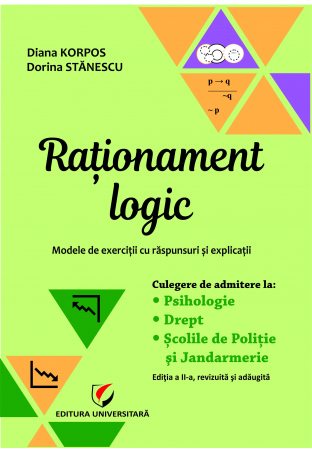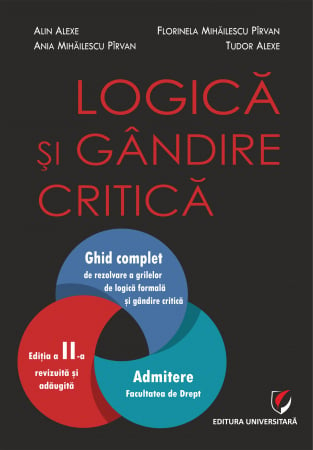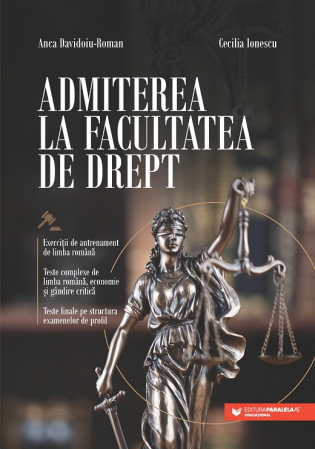ISBN: 978-606-591-684-5
DOI: 10.5682/9786065916845
Publisher year: 2013
Edition: I
Pages: 274
Publisher: Editura Universitară
Author: Constantin Gogoneata, Basarab Gogoneata
- Description
- Authors
- Content
- More details
- Reviews (0)
"FAST AND EFFICIENT LEARNING ECONOMY METHODS" by teachers Constantine and Basarab Gogoneata will help you get started even when there are only a few months to baccalaureate exams and admission faculties economic, legal or technical across the country, ready for any competition without the grind and stress.
Working daily, systematic lessons one chapter with diagrams and formulas, while also advancing, returning the modules and structures "method of learning economy", you will be able to think independently and ambition to succeed in the competition will becomes a necessary passion to accomplish your professional in any field of economic life.
Success!
BASARAB GOGONEATA
Foreword / 9
Part one / 15
Models of studying economics / 15
1. Needs and resources. Economic activity / 15
1.1. Needs and human activity / 16
1.2. Their resources and limits / 16
1.3. Rationality of resource use / 17
1.4. YES or NO / 17
1.5. Completed / 18
1.6. Choose the best answer / 19
2. Economy - a diverse reality / 20
2.1. Natural economy and exchange economy / 20
2.2. The universe of economics / 21
2.3. The characteristics of the modern economy / 22
2.4. YES or NO / 23
2.5. Completed / 23
2.6. Choose the best answer / 24
3. Market economy / 26
3.1. Market economy system / 26
3.2. Property / 27
3.3. Free initiative / 27
3.4. YES or NO / 28
3.5. Completed / 29
3.6. Choose the best answer / 29
4. Money / 31
4.1. The origin, evolution and functions of money / 31
4.2. Money supply and purchasing power of the currency / 32
4.3. Currency convertibility / 33
4.4. YES or NO / 34
4.5. Completed / 34
4.6. Choose the best answer / 35
5. Production factors / 37
5.1. What are the production factors / 37
5.2. Work / 38
5.3. Nature / 38
5.4. Capital / 39
5.5. Progress of production factors / 40
5.6. YES or NO / 40
5.7. Completed / 41
5.8. Choose the best answer / 41
6. Technical progress / 43
6.1. Technical progress and economic progress / 43
6.2. Innovation / 44
6.3. Technical progress and society / 44
6.4. YES or NO / 45
6.5. Completed / 46
6.6. Choose the best answer / 46
7. Use of production factors. Cost / 48
7.1. Combination of production factors / 48
7.2. Production cost / 4
7.3. YES or NO / 50
7.4. Completed / 51
7.5. Choose the best answer / 52
8. Productivity / 54
8.1. Productivity of production factors / 54
8.2. Forms of productivity / 55
8.3. YES or NO / 56
8.4. Completed / 56
8.5. Choose the best answer / 57
9. Consumer and economic utility / 60
9.1. Economic utility / 60
9.2. Rational consumer choice / 61
9.3. YES or NO / 62
9.4. Completed / 63
9.5. Choose the best answer / 64
10. The market / 67
10.1. What is the market? / 67
10.2. Application / 68
10.3. Offer / 69
10.4. Price and market equilibrium / 70
10.5. YES or NO / 71
10.6. Completed / 72
10.7. Choose the best answer / 72
11. Competitor / 76
11.1. How does competition manifest itself? / 76
11.2. The market with perfect competition / 77
11.3. The market with imperfect competition / 77
11.4. Competitive strategies / 78
11.5. YES or NO / 79
11.6. Completed / 79
11.7. Choose the best answer / 80
12. Money market / 82
12.1. Demand and supply of currency / 82
12.2. Money market operations / 83
12.3. Money market and cash availability / 84
12.4. YES or NO / 85
12.5. Completed / 86
12.6. Choose the best answer / 86
13. Capital market / 89
13.1. Shares and bonds / 89
13.2. Forms of the financial market / 90
13.3. The role of the stock exchange / 91
13.4. YES or NO / 92
13.5. Completed / 92
13.6. Choose the best answer / 93
14. Labor market. Salary / 95
14.1. Job demand and supply / 95
14.2. Salary / 96
14.3. YES or NO / 98
14.4. Completed / 98
14.5. Choose the best answer / 99
15. Profit / 103
15.1. Profit - result of economic action / 103
15.2. Owners of production factors and profit / 104
15.3. YES or NO / 105
15.4. Completed / 106
15.5. Choose the best answer / 107
16. Income, consumption and investments / 110
16.1. The results of the economic activity / 110
16.2. Income and consumption / 111
16.3. Savings and investments / 112
16.4. YES or NO / 114
16.5. Completed / 114
16.6. Choose the best answer / 115
17. Efficiency and economic balance / 117
17.1. Economic efficiency / 117
17.2. Economic balance / 118
17.3. YES or NO / 119
17.4. Completed / 120
17.5. Choose the best answer / 120
18. Unemployment / 123
18.1. What is unemployment? / 123
18.2. Diminishing unemployment and its effects / 124
18.3. YES or NO / 125
18.4. Completed / 125
18.5. Choose the best answer / 126
19. Inflation / 129
19.1. What is inflation / 129
19.2. Mechanisms of inflation / 130
19.3. Anti - inflationary measures / 131
19.4. YES or NO / 131
19.5. Completed / 132
19.6. Choose the best answer / 133
20. Fluctuations of economic activity / 135
20.1. Characterization of cyclicality in the economy / 135
20.2. The economic cycle and its phases / 136
20.3. Countercyclical policies / 137
20.4. YES or NO / 138
20.5. Completed / 138
20.6. Choose the best answer / 139
21. State and economy / 141
21.1. The state in the market economy / 141
21.2. State financial resources and their use / 142
21.3. Economic programming / 143
21.4. YES or NO / 144
21.5. Completed / 144
21.6. Choose the best answer / 145
22. World market / 147
22.1. The world market and its forms / 147
22.2. International trade / 148
22.3. Efficiency of foreign trade / 149
22.4. YES or NO / 150
22.5. Completed / 151
22.6. Choose the best answer / 148
23. Foreign exchange market / 153
23.1. Demand, supply and exchange rate / 153
23.2. Foreign exchange operations / 154
23.3. Interbank foreign exchange market / 155
23.4. YES or NO / 156
23.5. Completed / 156
23.6. Choose the best answer / 157
24. Economy of Romania / 159
24.1. Economic reform / 159
24.2. Participation in the world market / 160
24.3. Integration in the structures of the European economy / 161
24.4. YES or NO / 162
24.5. Completed / 162
24.6. Choose the best answer / 163
25. Global problems of the world economy / 165
25.1. Globalization of human problems / 165
25.2. Food crisis and underdevelopment / 166
25.3. Pollution / 167
25.4. YES or NO / 168
25.5. Completed / 168
25.6. Choose the best answer / 169
Part II / 17
Formulas used in economics / 171
Part III / 171
Small economic dictionary / 181
Part IV / 191
Verification tests / 191
Test 1/191
Test 2/196
Test 3/201
Test 4/206
Test 5/211
Part V / 217
Subjects of admission 2001 with solutions / 217
1. Higher economic studies / 217
2. Higher economic studies / 219
3. Higher economic studies / 222
4. Higher economic studies / 224
5. Higher economic studies / 228
6. Higher economic studies / 231
7. Higher economic studies / 234
8. Higher economic studies / 238
9. Higher economic studies / 241
10. Higher economic studies / 244
11. Higher legal studies / 247
12. Higher economic studies / 255
13. Higher economic studies / 257
14. Higher education studies / 260
15. Higher economic studies / 265
Part VI / 273
Traps - be careful! / 273
Economics, as a competition discipline, has a certain degree of difficulty, through the multitude of concepts, legalities, relationships, formulas, classifications, objective, subjective factors, micro and macroeconomic structures. You need to know its alphabet and decipher its message, knowing from the experience of so many generations of students, that this science opens wide windows to the professions of the present and the future.
With our teaching experience and with the support of the Editura Universitara we offer to all those who have a love of learning and an intense desire to make a career in finance, banking, insurance, management, marketing, economic engineering, law, political science, etc., this paper entitled Method fast and efficient learning of Economics.
The organization of the book follows the idea of presenting a fast, pleasant and useful method of passionately learning modern economic theory.
Part I, Models of the study of Economics includes twenty-five topics from the textbook and curriculum of the discipline, recommended for baccalaureate and admission to the faculties where Economics is the competition test.
For each topic we selected the most important problems and concepts necessary to be known and we presented the schemes for fixing the teaching material, and to these are added thirty tests in three modules: with "YES and NO", "Complete" and " Choose the best answer ".
Part II is the "Formulas used in Economics" that are needed to solve economic problems. Rewrite these formulas, solve as many problems as possible and build your own examples with variables in dynamics, as required for the baccalaureate. At admission, the problems have a higher score than the usual tests.
Part III "Small economic dictionary" will help you learn the basics of economics, to present them correctly in the baccalaureate papers. And college admission focuses on grids that can be solved only by knowing the notions perfectly. Sometimes, replacing a simple preposition can change the meaning of the definition, and the choice of answer may be wrong.
Part IV contains 5 sets of thirty grid tests, with the choice of a good answer from several variants.
Part V satisfies the justified curiosity of all those interested in knowing subjects given at admission in different university institutions and how to solve them.
In the sixth part "Traps - attention!" a series of grid tests are given, which require more attention.
Some will supplement your knowledge or explain a term or idea more. The theory is more easily retained starting from a problem or a test-grid. That's why I presented you some traps!
Therefore, the book is addressed to students who will participate in the baccalaureate, admission to the faculties of economics, economics, law, journalism, political science and even economics olympiads.
It can also be a working tool for our colleagues, teachers who teach Economics in schools and colleges. Due to their work, every year, the higher education institutions receive thousands of better and better prepared candidates and the level of admission - both at A.S.E., and at law, and at Politehnica - rises to high levels, of real competitions.
Dear students, you are looking forward to the entrance exam, in the book we have presented some more difficult notions, in order to encourage you to study and especially to make you curious and eager to know more, more and more! Always, you know, during training the teacher raises the bar as high as possible, to be sure that you will get the expected performances at the big competition!
If you want to focus your attention on the essential subject, at the beginning of the paper, you will find three schemes that will show you exactly which chapters you have to study in the first place, depending on the exam you have in front of you. They are designed in accordance with the analytical programs valid in 2013.
The authors and publishers of this book wish you much success, you, juniors of economics!
The Authors

6359.png)
![Fast and Efficient Method for Learning Economy [1] Fast and Efficient Method for Learning Economy [1]](https://gomagcdn.ro/domains/editurauniversitara.ro/files/product/large/metoda-de-invatare-rapida-si-eficienta-a-economiei-1332-449350.jpg)














